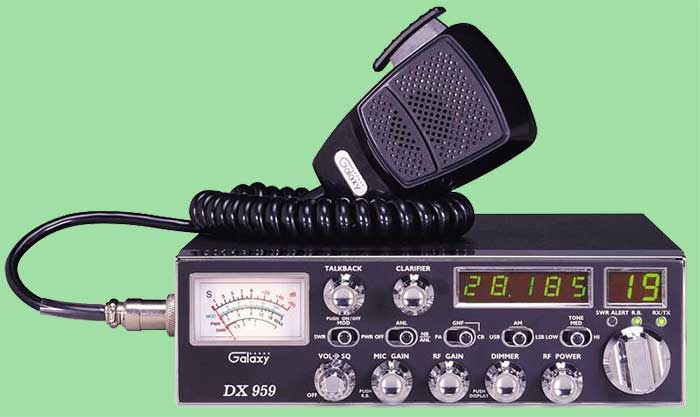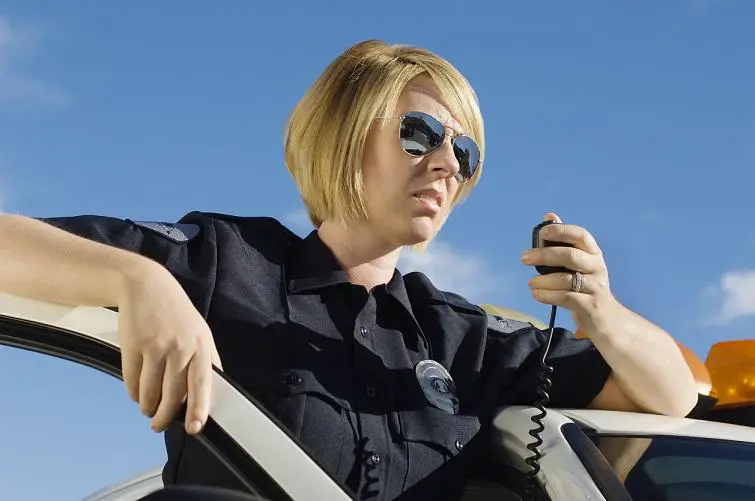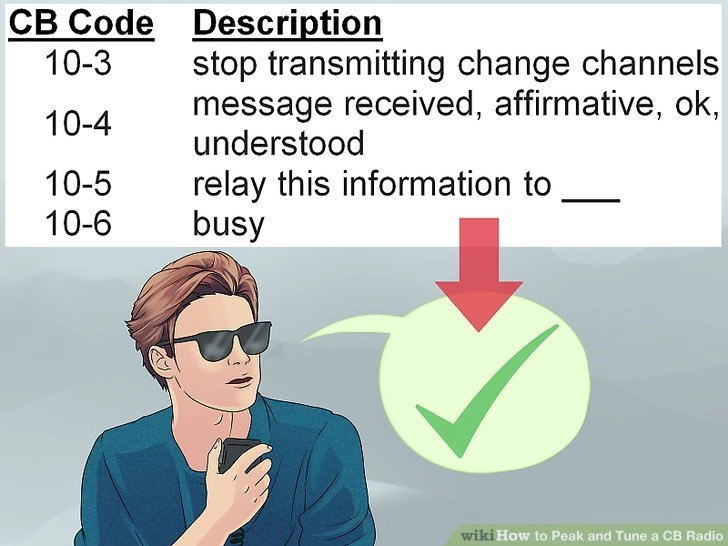Citizens Band radio, more commonly known as CB radio, has been around since the 1940s. CB radio frequencies were established by the FCC for business and personal communication as an alternative to Amateur Radio channels. CB has expanded greatly since its inception and currently includes 40 channels, most of which can be used by everybody.
What Caused CBs to Become So Popular?
CBs were fairly popular since the beginning but only began to see widespread use starting with the 70s. Back then, a major oil crisis prompted the US government to take several measures aimed at reducing fuel consumption. One of these measures involved reducing the maximum speed limit to only 55 mph on all national highways.

You may like: How Far do CB Radios Work?
Shortly after this measure was implemented, it became increasingly harder to find gas supplies due to nationwide rationing. This was particularly problematic for truck drivers who responded by setting up blockades as a sign of protest. Drivers used CBs to organize for these protests, as well as helping each other find fuel supplies along their routes.
What CB channel to use and What are the CB radio frequencies?
If you do not know what CB channel to use then our table CB frequencies bellow will help:
[su_table responsive=”yes”]
| CB Frequency | Citizens Band Channel | Customary Use |
|---|---|---|
| 26.965 | Citizens Band Channel 01 | open |
| 26.975 | Citizens Band Channel 02 | open |
| 26.985 | Citizens Band Channel 03 | open |
| 27.005 | Citizens Band Channel 04 | open–4×4 channel |
| 27.015 | Citizens Band Channel 05 | open |
| 27.025 | Citizens Band Channel 06 | open |
| 27.035 | Citizens Band Channel 07 | open |
| 27.055 | Citizens Band Channel 08 | open |
| 27.065 | Citizens Band Channel 09 | For emergency |
| 27.075 | Citizens Band Channel 10 | open–regional roads |
| 27.085 | Citizens Band Channel 11 | open |
| 27.105 | Citizens Band Channel 12 | open |
| 27.115 | Citizens Band Channel 13 | open–marine, RV |
| 27.125 | Citizens Band Channel 14 | open–walkie talkies |
| 27.135 | Citizens Band Channel 15 | open |
| 27.155 | Citizens Band Channel 16 | open (also for Single-sideband modulation) |
| 27.165 | Citizens Band Channel 17 | open -North/South Traffic |
| 27.175 | Citizens Band Channel 18 | open |
| 27.185 | Citizens Band Channel 19 | Truckers–East/West Hwy Traffic |
| 27.205 | Citizens Band Channel 20 | open |
| 27.215 | Citizens Band Channel 21 | open – regional roads |
| 27.225 | Citizens Band Channel 22 | open |
| 27.255 | Citizens Band Channel 23 | open |
| 27.235 | Citizens Band Channel 24 | open |
| 27.245 | Citizens Band Channel 25 | open |
| 27.265 | Citizens Band Channel 26 | open |
| 27.275 | Citizens Band Channel 27 | open |
| 27.285 | Citizens Band Channel 28 | open |
| 27.295 | Citizens Band Channel 29 | open |
| 27.305 | Citizens Band Channel 30 | open |
| 27.315 | Citizens Band Channel 31 | open |
| 27.325 | Citizens Band Channel 32 | open |
| 27.335 | Citizens Band Channel 33 | open |
| 27.345 | Citizens Band Channel 34 | open |
| 27.355 | Citizens Band Channel 35 | open |
| 27.365 | Citizens Band Channel 36 | open (also Single-sideband modulation) |
| 27.375 | Citizens Band Channel 37 | open (also Single-sideband modulation) |
| 27.385 | Citizens Band Channel 38 | open to all (also Single-sideband modulation, LSB) |
| 27.395 | Citizens Band Channel 39 | open to all (also Single-sideband modulation) |
| 27.405 | Citizens Band Channel 40 | open to all (also Single-sideband modulation) |
[/su_table]
Features to Look Out for Depending on Which CB Channels You are using
There are different types of features available for CB radios, some of which you’ll find more useful than others. The features you’ll want to look out for depend on what sort of channels you’re thinking about accessing. Continue reading to learn how and when to use these features to improve the quality of CB channels.

RF Gain: This particular feature can be used to create a filter that lets you receive only strong frequencies. RF Gain is very helpful in blocking weak transmissions and allows for clearer communication over strong frequencies. Alternatively, it can also be used to boost weak signals and achieve better clarity when communicating via any CB channel.
Automatic Noise Limiter: ANL is primarily used to eliminate static and background noise that might interfere with the transmission. This leads to much better sound quality and is particularly useful for those who drive large trucks with loud engines.
Instant Channel Functions: Allows you to quickly tune in to some of the most widely used CB channels like 9 and 19.
Weather Reporting Features: Just as its name suggests, this feature lets you receive real-time weather reports. Very useful for those who drive trucks, RVs, and most other types of vehicle.
Public Address (PA) Functions: Turns the radio into a public address system via a type of speaker known as a PA horn. This device is usually mounted on top of the vehicle and must be purchased separately.
Backlit Displays: Very useful for anyone driving during low visibility such as the evening or during cloudy weather. Usually only the more expensive radios include this feature.
Squelch Control: Completely eliminates static and other background noises when there’s no ongoing transmission present.
What is a Calling Frequency?
Think of a calling frequency as a sort of meeting room that anyone can access and initiate a transmission. For example, you can access these frequencies to inquire about points of interest in your specific area. Anyone listening in would then be able to reply and help you with information or directions.
Calling frequencies are not really meant for long conversations as that might distract fellow drivers. It is common courtesy to only use them for establishing contact and then move to a different frequency. Calling frequencies are sometimes used for emergencies so they should be free of chatter whenever possible.
What is The Most Commonly Used CB Channel?
There are a total of 40 CB channels that anyone can use provided they abide by some very simple rules. But while there are technically no restrictions as to what channels you can use, there are certain guidelines. As such, drivers quickly learn that some channels are more commonly used for certain purposes than others.
Channel 19 is known as the highway trucker channel and is likely the most commonly used one. Another commonly used one is #9, which is meant exclusively for emergency communications between operators. However, depending on the region you’re driving in, there might be other channels more commonly used then these.
What’s Above and Below the CB Channels?
Citizens Band frequencies range from Channel 1’s 26.965 MHz to Channel 40’s 27.405 MHz. Slightly above this range, one can find the Business Radio Service channels, which are used by various companies and institutions. Slightly above that, one can find (but shouldn’t try to access) the channels used by the federal government.
Meanwhile, below the CB channels are frequencies used by the US military and the Civil Air Patrol. CB radios are not normally able to access frequencies used by the military or the federal government. Modified radios have been known to bypass this limitation, however, doing so is illegal and punishable by law.
Are There Illegal CB Frequencies?
Frequencies higher than 28.000 MHz are used exclusively for Morse code by licensed ham radio operators. Certain modified CB radios can access those frequencies but it goes without saying that you should stay away from them. You’ll be noticed almost instantly if you try to communicate on those frequencies and that can get you into trouble.

Given that these frequencies are only used for Morse code, voice communication is strictly forbidden. Not even licensed operators will break this rule in order to alert you, though they’re likely to alert the FCC. In turn, the Federal Communications Commission might fine the company you’re working for, which can easily get you fired.
What are FRS and GMRS frequencies?
FRS stands for Family Radio Service and is a radio system that uses frequencies around 462 and 476 MHz. GMRS, or General Mobile Radio Service, is a similar system that uses the very same frequencies for short-distance two-way communication. Both systems use frequency modulation (FM) and generally offer better sound quality, albeit at the cost of reduced range.
Hybrid FRS/GMRS radios have become very popular lately, which prompted the FCC to recently revise the rules for these devices. Since September 2017, all FRS channels can be used by GMRS and vice-versa. As a result, hybrid FRS/GMRS radios can currently operate under a total of 22 different channels.
What is Freebanding?
Freebanding refers to the illegal use of channels that fall outside of the 10 kHz CB radio frequency. Generally speaking, these channels should only be accessed by those who have the proper authorization and license. It is possible to tap into these channels even without authorization, but there are consequences for doing so.
International call frequencies are among those that should not be accessed by operators without the proper authorization. Calling frequencies, in general, are not used for conversations and that goes double for international call frequencies. There is usually no penalty for listening in but talking tends to attract the attention of the FCC.
What Are the Penalties for Freebanding?
A lot of CB radio channels are used for emergencies and Freebanding can seriously disrupt important communications within these channels. Therefore, this practice is heavily frowned up by the FCC, which has no problem penalizing offenders. The commission is likely to first issue a warning but will not hesitate to issue penalties for repeat offenders.
Freebanding can lead to fines of as much as $10,000 or even more in some cases. The commission is also authorized to seize radio equipment if it deems necessary. In addition, the FCC is also likely to suspend any licenses related to other services that it regulates.
What are 10 codes for CB radio?
Here is a list of 10 codes for CB radio: Radio Codes
What does CB slang mean?
CB slang (Citizens Band slang) is the distinctive anti-language, argot or cant which developed among users of Citizens Band radio(Wikipedia.org). Here are some examples of CB slang.
- Twin Pets – A CB’er who has 2 sets from the same manufacturer
- Two miles of ditches for every mile of road – Drive safely, keep in the middle.
- Tx – Transmit
- U.C.B.T.A. – United CB Truckers Association
- Ungowa Bwana – O.K.
- Uncle Charlie – FCC
- Uppers and Lowers – Indicates that the radio will go above channel 40 and below channel 1
- USB – Upper Sideband
- USCRC – United States Citizens Radio Council
- Use the Jake – Slow down
Where Can I Legally Use my CB Radio Around the World?
It’s possible to use your CB radio in any territory where the FCC regulates radio services. This includes anywhere in the United States, as well as Puerto Rico, Navassa Island, the Caribbean, and the Virgin Islands. Your CB radio can also be used in other parts of the world provided you follow the local rules.

Rules and regulations can differ greatly from country to country so it’s a good idea to do some research beforehand. Some countries may require you to use certain pieces of equipment or additional licenses in order to use your radio. Likewise, certain frequencies that you can freely use in the US may be illegal in other parts of the world.
You may like:
- How Do You Install And Use A CB Radio
- Get A Comprehensive Guide To Buy CB Antenna
- How To Tune A CB Radio Antenna?
A great number of countries actually share the same CB radio frequencies as the US. However, there might be differences related to power levels and modes that you need to be aware of. Another thing to remember is that some countries might use more than the 40 CB channels used in the US.
Final Thought on CB Radios
Operating a CB radio can be quite an interesting hobby, but only if you know how to do it the right way. Hopefully, after reading this article, you will have enough information to start off your CB radio adventure the way you are supposed to. You will know which frequencies you’re allowed to use and where, not to mention that this article contains enough information to help you get the most of your CB radio experience!